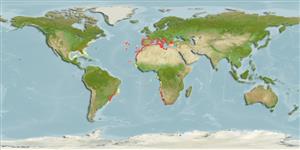Classification / Names
Common names from other countries
Main reference
Size / Weight / Age
Max length : 100.0 cm TL male/unsexed; (Ref. 3596); common length : 60.0 cm TL male/unsexed; (Ref. 3596)
Environment
Marine; benthopelagic; depth range 70 - 700 m (Ref. 52180), usually 80 - 240 m (Ref. 27121)
Climate / Range
Subtropical, preferred 24°C (Ref. 107945); 46°N - 35°S
Distribution
Eastern Atlantic: Spain and throughout most of the Mediterranean southward. Although reported to occur in South Africa (Ref. 4542, 6942), Smith 1995 (Ref. 11228) mentions that the species occurring in southern Africa is not Schedophilus ovalis but Schedophilus velaini. Western Central Atlantic: a small specimen recorded from Bermuda.
Countries | FAO areas | Ecosystems | Occurrences | Introductions
IUCN Red List Status (Ref. 115185)
Threat to humans
Harmless
Human uses
Fisheries: commercial
More information
ReferencesAquacultureAquaculture profileStrainsGeneticsAllele frequenciesHeritabilityDiseasesProcessingMass conversion
Tools
Special reports
Download XML
Internet sources
Estimates of some properties based on models
Phylogenetic diversity index
PD50 = 0.5039 many relatives (e.g. carps) 0.5 - 2.0 few relatives (e.g. lungfishes)
Trophic Level
3.5 ±0.47 se; Based on food items.
Resilience
Low, minimum population doubling time 4.5 - 14 years (Preliminary K or Fecundity.)
Vulnerability
High vulnerability (60 of 100)
Price category
